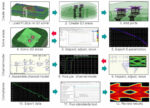You are currently viewing SemiWiki as a guest which gives you limited access to the site. To view blog comments and experience other SemiWiki features you must be a registered member. Registration is fast, simple, and absolutely free so please,
join our community today!
By Todd Burkholder and Per Viklund, Siemens EDA
The landscape of advanced IC packaging is rapidly evolving, driven by the imperative to support innovation on increasingly complex and high-capacity products. The broad industry trend toward heterogeneous integration of diverse die and chiplets into advanced semiconductor… Read More
According to a recent Samtec whitepaper, in high-data-rate (HDR) architectures, where signals traverse tens to hundreds of gigabits per second, “cable management” isn’t a housekeeping chore, it’s a first-order design variable. The mechanical path a cable takes directly influences channel loss, crosstalk, reliability,
…
Read More
2.5D and 3D multi-die design is rapidly moving into the mainstream for many applications. HPC, GPU, mobile, and AI/ML are application areas that have seen real benefits. The concept of “mix/match” for chips and chiplets to form a complex system sounds deceptively simple. In fact, the implementation and analysis techniques required… Read More
PCB and package designers need to be concerned with Signal Integrity (SI) issues to deliver electronic systems that work reliably in the field. EDA vendors like Siemens have helped engineers with SI analysis using a simulator called HyperLynx, dating all the way back to 1992. Siemens even wrote a 56-page e-book recently, Signal… Read More
Artificial intelligence (AI) is driving a transformation in data center infrastructure, necessitating cutting-edge technologies to meet the growing demands of AI workloads. As AI systems scale up and out, next-gen compute servers, switches, optical-electrical links, and flexible, redundant networking solutions are … Read More
Synopsys made significant announcements during the recent TSMC OIP Ecosystem Forum, showcasing a range of cutting-edge solutions designed to address the growing complexities in semiconductor design. With a strong emphasis on enabling next-generation chip architectures, Synopsys introduced both new technologies and … Read More
As clock speeds go up, voltages go down and data volumes explode the need for fast, reliable and low latency data channels becomes critical in all kinds of applications. Balancing the requirements of low power and high performance requires the mastery of many skills. At the top of many lists is the need for superior signal integrity,… Read More
PCB designers have been using manual routing for decades now, so when is it time to consider adding interactive routing technologies to become more productive? Manually routing traces to connect components will take time from a skilled team member and involves human judgement that will introduce errors. When a design change … Read More
PCB designers can perform pre-route simulations, follow layout and routing rules, hope for the best from their prototype fab, and yet design errors cause respins which delays the project schedule. Just because post-route analysis is time consuming doesn’t mean that it should be avoided. Serial links are found in many PCB designs,… Read More
Complexity and density conspire to make power delivery very difficult for advanced SoCs. Signal integrity, power integrity, reliability and heat can seem to present unsolvable problems when it comes to efficient power management. There is just not enough room to get it all done with the routing layers available on the top side… Read More










